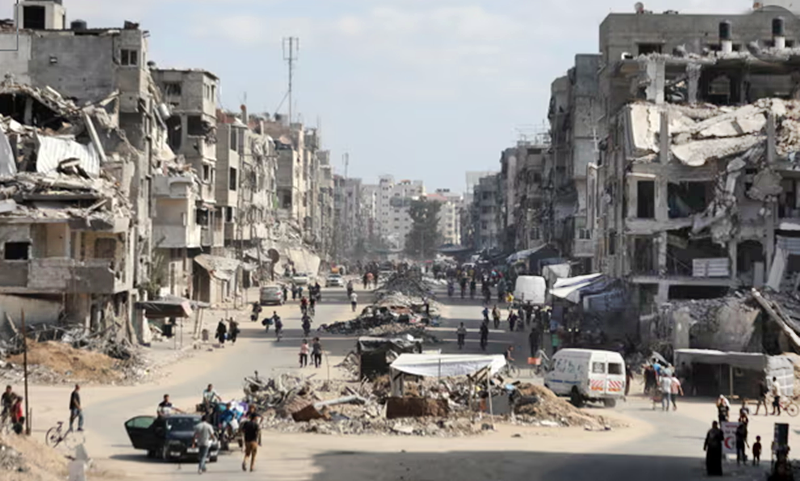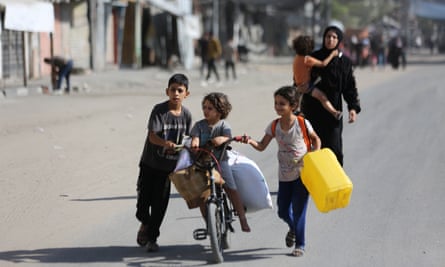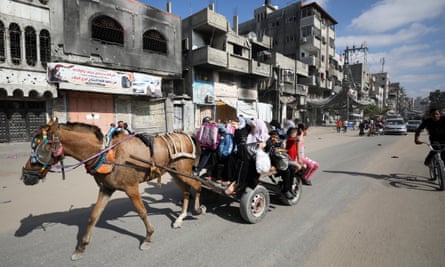‘The fear is unspeakable’: airstrikes on northern Gaza leave hundreds of thousands with nowhere to go.

By Guardian - Bethan McKernana - 12 Oct 2024 18.36 BST
Roughly 400,000 people trapped in latest offensive with most of territory under evacuation orders. At least 22 people have been killed in airstrikes in northern Gaza, with Israeli forces stepping up their campaign on the besieged Palestinian territory even as fighting in the new war in Lebanon escalates.
On Saturday, the Israel Defense Forces (IDF) renewed its evacuation orders for Palestinians still living in the decimated northern half of Gaza, although many residents say the fighting and Israeli sniper fire make it impossible to leave.
Avichay Adraee, an IDF spokesperson, told people that the area includes parts of Gaza City’s Sheikh Radwan neighbourhood and sections around Jabalia, the urban refugee camp.
In a social media post, Adraee asked people living there to head south to al-Mawasi, a coastal area of southern Gaza where hundreds of thousands of people are already displaced. A total of 84% of the territory is currently under evacuation orders, pushing civilians into ever-dwindling “humanitarian zones” which Israel has bombed regardless.
The UN says an estimated 400,000 people are trapped by the latest ground fighting and artillery fire centred in Jabalia, which has now entered a second week.
“It is getting tougher every day. The fear and the conditions are unspeakable,” said Badr Alzaharna, 25, from Gaza City. “I cannot leave. I want to travel but I can’t. Rafah crossing has been closed since May.”

Gaza’s ministry of health appealed on Friday for medical teams to be allowed access to the northern half of the strip to evacuate the wounded, and for fuel deliveries to the north’s struggling hospitals, warning that civilians caught up in the intense shelling and airstrikes are running out of food and water. Seven World Health Organization missions were impeded from access to northern Gaza by Israeli forces this week, the UN body said.
Also on Saturday, the World Food Programme, the UN food agency, reported that no food aid has reached northern Gaza since 1 October, with a 35% drop in the supply of food to families around the rest of Gaza, raising new fears of extreme hunger and famine that have already plagued the strip for a year.
The last food supplies – canned food, flour, high-energy biscuits and nutrition supplements – have been distributed to shelters and health facilities in the north, and it is unclear how long they will last. Israel has consistently denied blocking aid and food to Gaza.
Airstrikes overnight on Friday on Jabalia destroyed an entire building and severely damaged several more, according to medics and first responders, who are still recovering missing people from under the rubble and ruins created by a 20-metre deep impact crater.
At least six women and seven children were among the dead, and a strike in another part of Jabalia in the early hours of Saturday killed two parents and injured their baby, the health ministry in the Hamas-run territory said. Hospitals across Gaza reported receiving a total of 49 bodies and 219 wounded people in the past 24 hours.

The IDF did not immediately respond to a request for comment on the latest strikes and civilian deaths in Gaza.
Israel has nominally controlled the northern half of Gaza since the beginning of the year, and has cut the territory in two by creating what it calls the Netzarim corridor, which separates what was once the densely populated Gaza City from the rest of the strip. However, it has since frequently re-entered Gaza City and other areas in the north of the strip where it says Hamas fighters are regrouping.
In Lebanon, the health authority said that 60 people were killed and another 168 wounded in the past 24 hours, and the United Nations peacekeeping force that operates on the blue line separating Israel and Lebanon said its headquarters in Naqoura had been targeted a second time. It was not immediately clear who was responsible for the fire.
Israel stepped up its campaign against the Lebanese militia Hezbollah last month after a year of tit-for-tat fire triggered by Hamas’s 7 October attack and the ensuing war in Gaza.
The new war in Lebanon has heightened the risk of a region-wide escalation drawing in Iran and the US. Ceasefire talks on ending the fighting in Gaza have been stalled since July.
